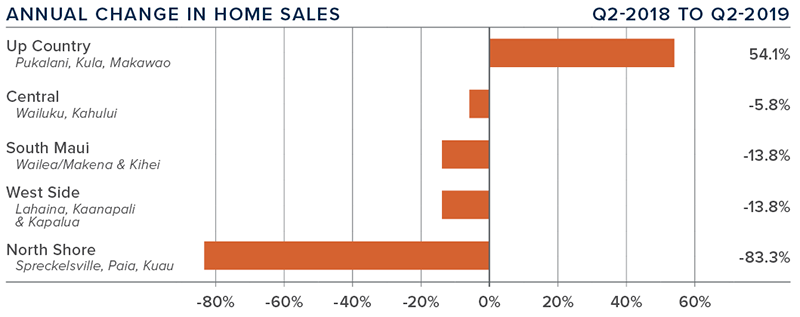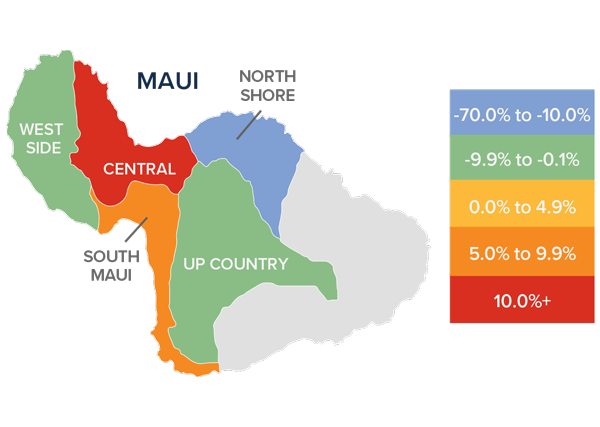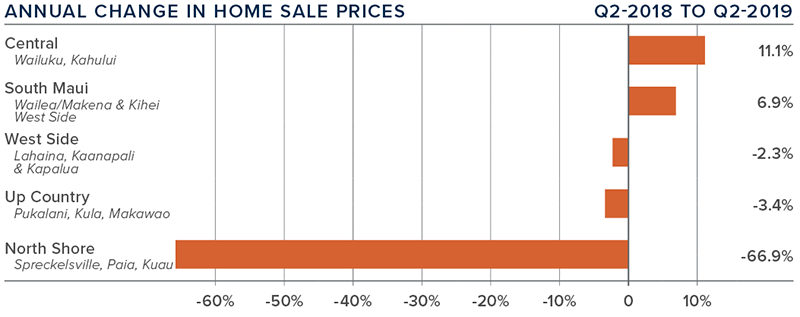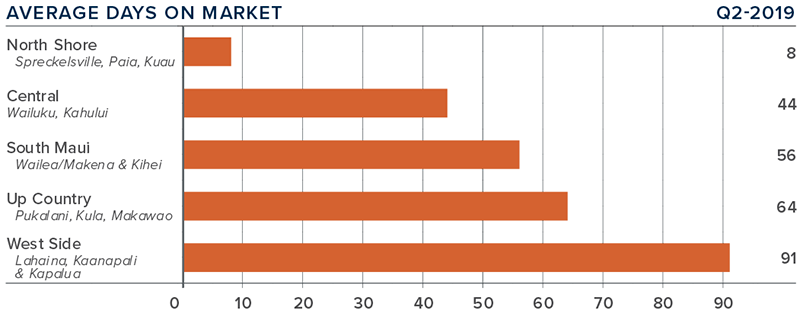The following analysis of select Maui real estate markets is provided by Windermere Real Estate Chief Economist Matthew Gardner. We hope that this information may assist you with making better-informed real estate decisions. For further information about the housing market in your area, please don’t hesitate to contact your Windermere agent.
ECONOMIC OVERVIEW
The tepid pace of employment growth in Hawaii continues. Only 1,200 jobs were added over the past 12 months, representing an annual growth rate of 0.2%. In June, the state’s unemployment rate was 2.8% — a figure that has remained static for the past four months — but it is up from 2.4% a year ago.
On the island of Maui, employment continues to contract, with a 3% drop year-over-year. Employment growth has been negative for the past 18 months. The island’s unemployment rate was 3%, up from 2.8% a year ago.
HOME SALES
- In the second quarter of 2019, 573 homes sold. This was a drop of 9.2% compared to the second quarter of 2018, but an increase of 16.9% compared to the first quarter of this year.
- Just one market saw growth in sales compared to the second quarter of 2018. As for sales declines, the very small North Shore market experienced a significant drop, but the total contraction in sales was just 10 units.
- The decline in sales came as inventory levels dropped 5.6%. Three market areas saw listing inventories rise: the Central area, North Shore, and Up Country. Lower inventory levels were experienced in South Maui and the West Side.
- Pending home sales in the quarter were down 2.9% from the first quarter of 2019, suggesting that third quarter closings may also disappoint.

HOME PRICES
- The average home price in the region rose 2.1% year-over-year to $883,805.
- Affordability continues to be a significant issue. The noticeable drop in interest rates this year has failed to stimulate sales but has allowed average prices to continue to rise.
- Price changes were a mixed bag, with growth in two market areas and declines in three. The North Shore market had a 66.9% drop in prices, but this is a very small area, making it prone to significant price swings.
- Even given affordability constraints in many Maui market areas, I believe home prices will rise further in 2019, though at fairly modest rates.

DAYS ON MARKET
- The average number of days it took to sell a home on Maui dropped 21 days compared to the second quarter of 2018.
- The amount of time it took to sell a home dropped in all markets other than in Up Country.
- In the second quarter, it took an average of 53 days to sell a home. Homes in the North Shore market sold at the fastest pace, while West Side homes took the longest time to sell.
- Even as sales slowed, housing demand remained strong, as the drop in market time demonstrates. I continue to anticipate we will see modestly rising activity as we move through the balance of the year.

CONCLUSIONS
 This speedometer reflects the state of the region’s real estate market using housing inventory, price gains, home sales, interest rates, and larger economic factors.
This speedometer reflects the state of the region’s real estate market using housing inventory, price gains, home sales, interest rates, and larger economic factors.
For the second quarter of 2019, I have moved the needle a little more in favor of home sellers. The market is showing some signs of trending back toward equilibrium, but we are not there yet. The lack of inventory favors sellers with continued price growth.
ABOUT MATTHEW GARDNER
 As Chief Economist for Windermere Real Estate, Matthew Gardner is responsible for analyzing and interpreting economic data and its impact on the real estate market on both a local and national level. Matthew has over 30 years of professional experience both in the U.S. and U.K.
As Chief Economist for Windermere Real Estate, Matthew Gardner is responsible for analyzing and interpreting economic data and its impact on the real estate market on both a local and national level. Matthew has over 30 years of professional experience both in the U.S. and U.K.
In addition to his day-to-day responsibilities, Matthew sits on the Washington State Governors Council of Economic Advisors; chairs the Board of Trustees at the Washington Center for Real Estate Research at the University of Washington; and is an Advisory Board Member at the Runstad Center for Real Estate Studies at the University of Washington where he also lectures in real estate economics.
 Facebook
Facebook
 X
X
 Pinterest
Pinterest
 Copy Link
Copy Link



